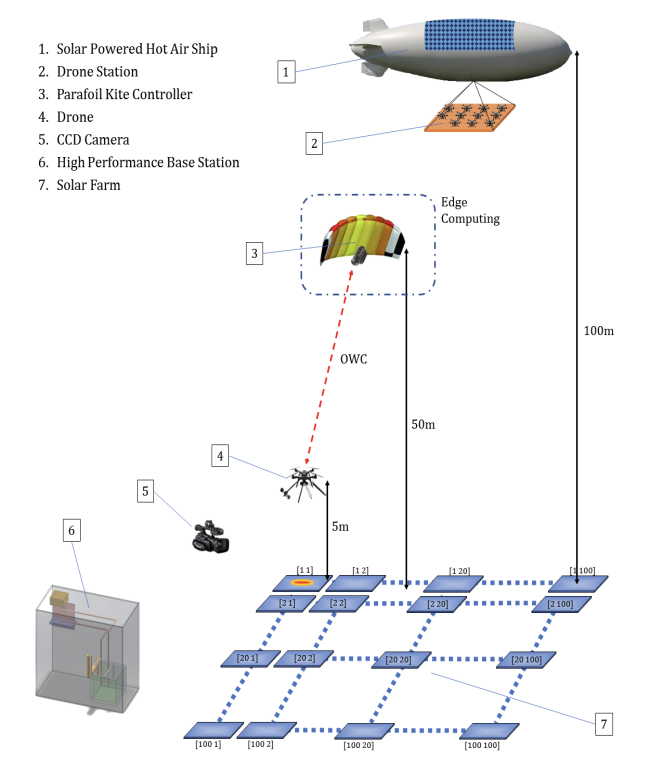This invention focuses on improving the cooling of high-performance base stations used in solar farm surveillance. It introduces a method called precise cold finger cooling (PCFC) to replace less efficient air cooling. The system uses drones and parafoil kites equipped with infrared cameras to monitor solar panels for hotspots caused by issues like aging or damage. When a hotspot is detected, drones are instructed to cool it using ice-cooled water, preventing damage and maintaining power efficiency. This approach ensures reliable operation of base stations, even under heavy loads, by effectively managing heat and improving the overall efficiency of solar farm monitoring systems.
- Precise Cold Finger Cooling (PCFC) Technique: Utilizes liquid nitrogen (LN2) to cool high-performance base station components, ensuring efficient temperature control and preventing system crashes during high-load conditions.
- Airborne 2D NUI Imaging Application: Incorporates parafoil kite controllers with IR cameras and drones for monitoring solar farms, enabling dynamic detection and precise mitigation of hotspots to protect solar panels and optimize energy generation.
- Intelligent Surveillance Environment: Integrates solar-powered hot airships and drones for real-time health monitoring and power estimation, providing a self-sustaining, eco-friendly solution for managing large-scale solar farms.
- Overclocking and Dynamic Cooling: Allows overclocking of base station processors during peak loads, coupled with dynamic cooling to manage excess heat, enhancing processing power without the risk of overheating and ensuring uninterrupted operation of surveillance systems.
- Optical Wireless Communication (OWC): Facilitates communication between parafoil kite controllers and drones using optical wireless channels, ensuring secure, low-latency data transmission for accurate hotspot detection and timely response.
- Ice-Cooled Water Sprinkling: Uses drones to sprinkle ice-cooled water on detected hotspots, providing a targeted cooling solution that effectively mitigates hotspots and prevents damage to solar panels.
202022047959
- Enhanced Solar Farm Efficiency: Increases the efficiency and longevity of solar panels, leading to more reliable and sustainable energy production, reducing reliance on fossil fuels.
- Improved Energy Security: Ensures consistent energy generation from solar farms, contributing to energy security and stability for communities.
- Environmental Protection: Reduces greenhouse gas emissions by maximizing the effectiveness of renewable energy sources, contributing to climate change mitigation.
- Economic Benefits: Lowers operational and maintenance costs of solar farms through precise hotspot detection and cooling, making renewable energy more cost-effective.
- Public Health Improvement: Decreases air pollution by supporting cleaner energy production, leading to better health outcomes for communities.
Renewable Energy, Aerospace, Information Technology, Environmental Monitoring, Smart Grid, Cooling Technology, Telecommunications, Surveillance And Security
Solar Farm Management, Renewable Energy Monitoring, Precision Cooling Systems, Airborne Imaging Technology, Computational Load Balancing, Smart Grid Technology, Environmental Sustainability, Advanced Surveillance Systems
460467


